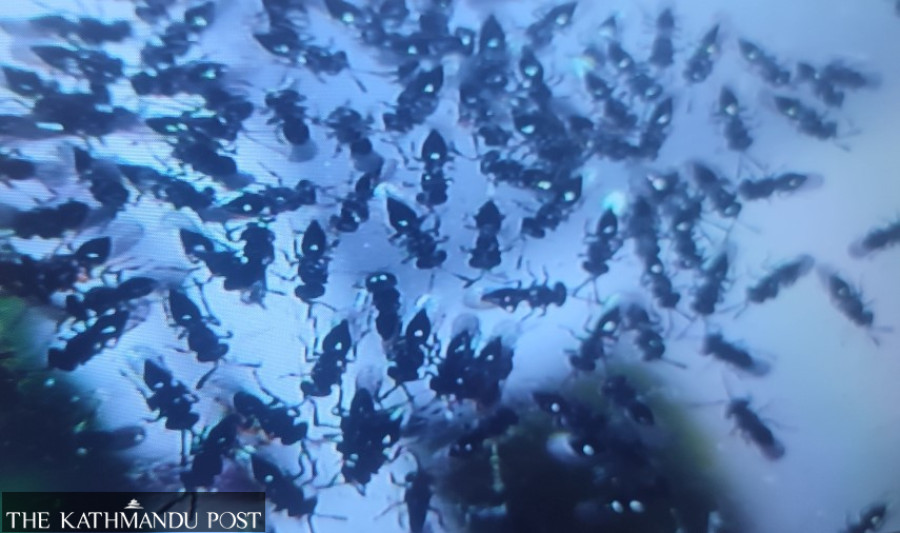Money
Nepal scientists confirm old remedy for armyworm
Researchers at Agriculture University, Rampur develop a tube to grow wasps and fungus that destroy the pest.
Ramesh Kumar Paudel
In 2019, the fall armyworm arrived in Nepal and destroyed crops, particularly maize, in a large swathe of land belonging to thousands of farmers across the country. The risk of armyworm invasion is not over, and experts have cautioned that they could strike back.
Now, agro-scientists say they have a remedy.
Scientists at the Agriculture and Forestry University at Rampur in Chitwan said they now have a twin strategy to destroy fall armyworm.
“We have developed a tube in our lab, in which we grow wasps or hornets and fungus. The wasp destroys the eggs of armyworms,” said Sundar Tiwari, associate professor at the Agriculture and Forestry University. “Even if the larva of armyworms grow from the eggs not destroyed by wasps, the fungus will kill them.”
Past research had found it extremely difficult to eradicate armyworm due to its high migratory ability, broad feeding habits, and the significant resistance it exhibits to a wide range of insecticides.
In addition, the larva of the fall armyworms are usually hidden in the inner leaves of the maize wheel, and the leaves are commonly covered with faeces, which reduces the direct contact of the insects with the insecticide.
“Pests can kill armyworms. Chemical pesticides are not required,” said Tiwari. The cultured wasps or hornets deposit eggs where the armyworms lay eggs. “The eggs of hornets will suck the rich nutrients out of armyworm eggs as it grows into lavra. This way, the life of armyworms ends and the life of wasps begins.”
Scientists say this method is plan ‘A’.
Nisha Subedi, who is in the final semester of her Master's course in Agriculture science at the university, and her team developed the tube where fungi are produced. This is plan ‘B’.
If plan ‘A’ fails and the larva of armyworm are developed, plan ‘B’ will come into play. The fungus grown in the tube will end the life of the armyworm larva.
Subedi and her colleague Laxman Chaudhary have successfully grown fungus in the tube.
The tubes are installed in areas where armyworms are present, said Tiwari.
Among the wasp species, ‘Telenomus remus’ is effective in controlling fall armyworms, according to research.
Several other studies had found Telenomus remus as an efficient egg parasitoid wasp useful for the control of fall armyworms.
Some species of parasitic wasps, especially in groups such as Aphelinidae, Braconidae, Mymaridae, and Trichogrammatidae, were exploited to provide biological control of insect pests nearly a century ago.
According to reports, one of the first species to be used was Encarsia formosa, a parasitoid of a range of whitefly species. It entered commercial use in the 1920s in Europe and was overtaken by chemical pesticides in the 1940s.

The egg parasitoid wasp and fungus is a cheaper alternative for farmers to control fall armyworms than pesticides, said Tiwari.
Tiwari said that each tube contains 2,500 wasps. Among them, 1,200 or half would be female. “Our research has shown that a tube can destroy 24,000 armyworm eggs,” said Tiwari.
The fungus Metarhizium rileyi has also proven effective to control the growth of armyworm larva, said Min Raj Pokhrel, another professor at the university.
Metarhizium rileyi is an entomopathogenic fungus that naturally infects the larvae of Spodoptera frugiperda, and has biocontrol potential.
Ghanashyam Bhandari, another agriculture scientist at the National Agriculture Research Centre, said that armyworm, an American native, has been troubling farmers for the past few years and the tubes could be an effective solution to control armyworms.
After multiple surveillance field visits and the investigation of many suspected samples, Nepal’s Plant Quarantine and Pesticide Management Centre declared the invasion of fall armyworm on August 12, 2019. The insect is an international quarantine pest and a major threat to maize production and productivity.
A migratory insect pest native to the Americas, the fall armyworm has caused a significant loss estimated in billions of dollars in many African countries that grow maize since it was first identified on the African continent in 2016.
The invasive pest was first detected in the Indian subcontinent in May 2018 in maize fields at the College of Agriculture, Shivamogga, Karnataka.
Studies show that in Africa, the fall armyworm has the potential to cause maize yield losses ranging from 21 to 53 percent destroying 8.3 to 20.6 million tonnes of annual production if left uncontrolled. It presents a serious threat to food and income security for millions of smallholder farmers.
Growing in tropical weather conditions, the female moth of a fall armyworm can lay thousands of eggs in her lifetime and the moth’s strong flying capability makes it difficult to eradicate.
The Ministry of Agriculture and Livestock Development has established a special task force to fight back the pest.
Armyworm has now spread in 66 districts—both in the hills and the Tarai—where maize is cultivated, Bhandari said.
The adult moth can travel over 100 kilometres per night, and with the help of good wind, it has been known to travel more than 1,000 kilometres in 30 hours. The female moth produces 1,000 eggs. In the adult stage, the fall armyworm reproduces quickly.
“The adult stage of armyworm is 22–23 days. In this stage, it can fly from 1,500 to 2,000 km, virtually reaching anywhere,” Bhandari said. These characteristics got it the name ‘armyworm’.
When maize plants start growing with 3–4 leaves, armyworms start attacking. Therefore, farmers need to watch maize plants from the initial days, Bhandari said.
Arjun Shrestha, dean of the agriculture faculty, said the university is looking for partners to make this technology available to farmers, by distributing wasps and fungus in big quantities.
“If the private sector is interested in the project, the outcome could benefit tens of thousands of farmers.”




 6.12°C Kathmandu
6.12°C Kathmandu1.jpg)















